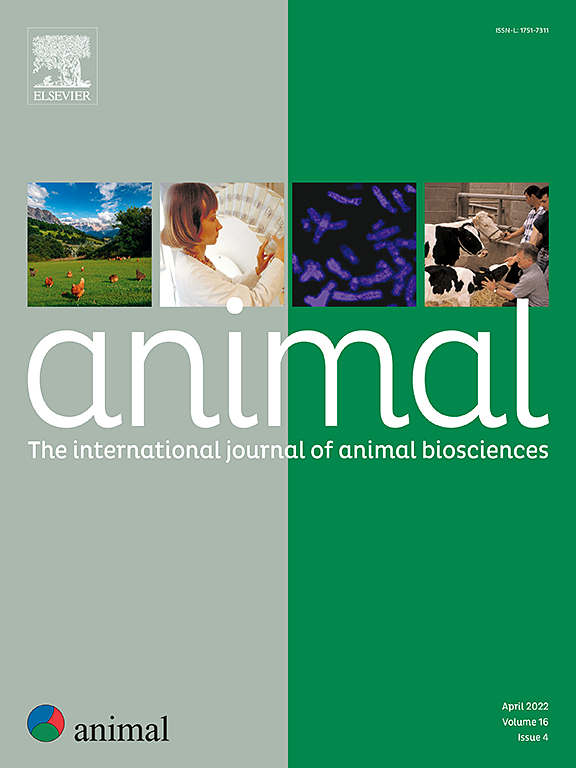Environmental impact of rabbit production systems: a farm-based cradle-to-gate analysis
IF 4
2区 农林科学
Q1 AGRICULTURE, DAIRY & ANIMAL SCIENCE
引用次数: 0
Abstract
Rabbit meat could represent a sustainable protein source in a context of growing demand for animal products, but information about its environmental footprint and key hotspots along the production chain remain limited. The present study aimed at providing a multifaceted evaluation of the environmental impact associated with rabbit meat production considering the whole production cycle, by using primary data collected from 46 commercial farms and six interviews with academic and industry experts and technicians of the field. An attributional cradle-to-gate Life Cycle Assessment model encompassed all the main production stages, from the birth of the rabbits to their sale to the slaughterhouse, and included two sub-models covering the breeding and the fattening phases. System boundaries were set to consider the impact associated with the animal and manure management, the production of the feeds consumed by animals and the farm use of the energy sources. The assessed impact categories were global warming potential (GWP, kg CO2-eq), acidification potential (AP, g SO2-eq), eutrophication potential (EP, g PO4-eq), cumulative energy demand (CED, MJ), land occupation (LO, m2/y), abiotic depletion – elements (ADE, mg Sb-eq) and fossil energy (MJ), water scarcity (m3-eq) and terrestrial (TECO, kg 1–4,DB), freshwater (FECO, kg 1–4,DB) and marine (MECO, kg 1–4,DB) ecotoxicity. The functional unit was 1 kg live weight (LW), and the time reference was 1 year. Considering the whole production cycle, the production of 1 kg LW of meat rabbit generated an average of 2.56 kg CO2-eq (GWP) and 3.19 kg CO2-eq (GWP_LUC) with gas contribution 60% CO2, 26% N2O, 14% CH4; 46 g SO2-eq (AP), 21 g PO4-eq (EP), 32 MJ (CED), 4.6 m2 (LO) and 2.4 m3-eq (water scarcity). The average values for abiotic depletion categories were 2.6 mg Sb-eq (ADE) and 24 MJ (abiotic depletion – fossil energy); ecotoxicity values were 0.3, 2.9 and 269 kg 1,4-DCB for TECO, FECO and MECO, respectively. The fattening phase contributed more (65%, on average) than the breeding phase (35%) to the environmental impact for all the impact categories. Feed production accounted for more than 65% of the impact in EP, CED, water scarcity and abiotic depletion – fossil energy categories, and almost the unique responsible (98–100%) for LO, TECO and FECO categories. According to our study, the environmental impact of rabbit meat production is intermediate between those of poultry and pig meat productions. The fattening phase emerged as a priority area for future mitigation strategies that will address the impact related to feed production.
兔子生产系统的环境影响:基于农场从摇篮到大门的分析
在对动物产品需求不断增长的背景下,兔肉可能是一种可持续的蛋白质来源,但有关其环境足迹和生产链上关键热点的信息仍然有限。本研究旨在通过使用从46个商业农场收集的原始数据和对该领域的学术和工业专家和技术人员的六次访谈,从考虑整个生产周期的角度对兔肉生产对环境的影响进行多方面的评估。归因生命周期评估模型涵盖了从兔子出生到出售到屠宰场的所有主要生产阶段,并包括两个涵盖育种和育肥阶段的子模型。系统边界的设置考虑了与动物和粪便管理、动物消耗的饲料生产和农场使用能源相关的影响。评估的影响类别包括全球变暖潜势(GWP, kg CO2-eq)、酸化潜势(AP, g SO2-eq)、富营养化潜势(EP, g PO4-eq)、累积能量需求(CED, MJ)、土地占用(LO, m2/y)、非生物耗竭元素(ADE, mg sg -eq)和化石能源(MJ)、水资源短缺(m3-eq)和陆地(TECO, kg 1-4,DB)、淡水(FECO, kg 1-4,DB)和海洋(MECO, kg 1-4,DB)生态毒性。功能单位为1 kg活重(LW),参照时间为1年。考虑到整个生产周期,肉兔每生产1 kg LW平均产生2.56 kg CO2-eq (GWP)和3.19 kg CO2-eq (GWP_LUC),气体贡献为CO2 60%, N2O 26%, CH4 14%;46 g SO2-eq (AP), 21 g PO4-eq (EP), 32 MJ (CED), 4.6 m2 (LO)和2.4 m3-eq(缺水)。非生物耗竭类别的平均值为2.6 mg Sb-eq (ADE)和24 MJ(非生物耗竭-化石能源);TECO、FECO和MECO的生态毒性值分别为0.3、2.9和269 kg 1,4- dcb。在所有影响类别中,育肥阶段对环境影响的贡献(平均为65%)大于繁殖阶段(35%)。饲料生产对EP、CED、水资源短缺和非生物耗竭(化石能源)类别的影响占65%以上,对LO、TECO和FECO类别的影响几乎是唯一的(98-100%)。根据我们的研究,兔肉生产对环境的影响介于家禽和猪肉生产之间。育肥阶段成为未来缓解战略的优先领域,将解决与饲料生产有关的影响。
本文章由计算机程序翻译,如有差异,请以英文原文为准。
求助全文
约1分钟内获得全文
求助全文
来源期刊

Animal
农林科学-奶制品与动物科学
CiteScore
7.50
自引率
2.80%
发文量
246
审稿时长
3 months
期刊介绍:
Editorial board
animal attracts the best research in animal biology and animal systems from across the spectrum of the agricultural, biomedical, and environmental sciences. It is the central element in an exciting collaboration between the British Society of Animal Science (BSAS), Institut National de la Recherche Agronomique (INRA) and the European Federation of Animal Science (EAAP) and represents a merging of three scientific journals: Animal Science; Animal Research; Reproduction, Nutrition, Development. animal publishes original cutting-edge research, ''hot'' topics and horizon-scanning reviews on animal-related aspects of the life sciences at the molecular, cellular, organ, whole animal and production system levels. The main subject areas include: breeding and genetics; nutrition; physiology and functional biology of systems; behaviour, health and welfare; farming systems, environmental impact and climate change; product quality, human health and well-being. Animal models and papers dealing with the integration of research between these topics and their impact on the environment and people are particularly welcome.
 求助内容:
求助内容: 应助结果提醒方式:
应助结果提醒方式:


